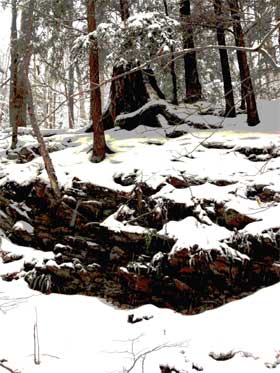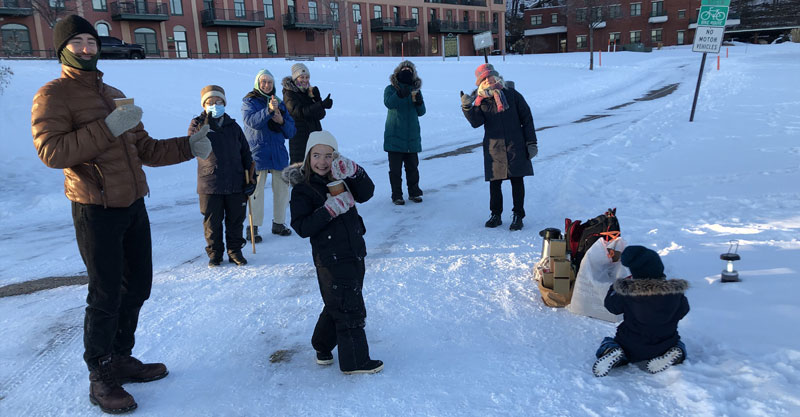from Marquette Monthly December, 2009
Peeking through a winter’s window
As darkness falls ever earlier these afternoons, those of us in Michigan’s Upper Peninsula huddle down to prepare for another winter. Along with splitting wood for our stoves and finishing up the last of canning from another fall harvest, the time of storytelling, dreams, feasts and lights has arrived. A world of elves, carols, community concerts, rituals and festivals teasingly invites us, especially during these first winter days, to take respite into a deeper, colorful landscape of imagination and soul.
Most all of us are aware that J.K. Rowling and her Harry Potter children’s book series have dazzlingly captured the focus of meeting an increasing popular hunger for magical and spiritual matters. Her work has taken her on a soaring path from writing stories at a corner table at McDonalds in a dreary London neighborhood to the life of a global celebrity. Even more recently, the film version of Maurice Sendak’s Where the Wild Things Are has drawn rave reviews from prestigious publications like the New York Times for leading us into still another celebration of the intriguing landscapes of dreams and inner worlds.
Against the backdrop of these gifted and popular contemporary storytellers, when all’s said and done, there’s little doubt, at least for large portions of the Western world, that C.S. Lewis’ Chronicles of Narnia still reigns—for our time—as the most beloved example of a writer who addresses powerful, complex realities in the form of elegantly crafted children’s stories. Lewis was a professor of classics and a medieval scholar at Oxford. Remarkably, he never traveled very far from his home. Lewis led a scholarly, relatively modest life, yet composed an award-winning series of children’s books that still offers readers, both on conscious and unconscious levels, a chance to explore playfully deep mysteries of psychological and spiritual insight. Reading the delightful, unfolding drama of the “Chronicles” is not unlike, for some of us, peeking through a winter’s window.
At the heart of Lewis’ captivating story line exists a land called Narnia, another name for hidden reservoirs of spiritual experience. Narnia is not a peaceful place, but a land of conflict where values of outer and inner worlds frequently clash in striking ways. When Lucy, Edmund, Peter and Susan inquire of the beavers in Narnia whether strange creatures (dwarfs, centaurs, Cyclops) in that land are dangerous, her newly discovered friends respond with a smile, saying in Narnia most of the time it’s just opposite from the human world. In Narnia, they explain, strange-looking creatures are beautiful on the inside. But in the human world, there are many beautiful and attractive people, but inside many of them are dangerous monsters.
“In general, take my advice,” Mr. Beaver says. “When you meet anything that’s going to be human and isn’t yet, or used to be human once and isn’t now, or ought to be human and isn’t, keep your eyes on it, and feel for your hatchet.”
The Chronicle tales are set in London during the WWII air raids, where four young children have been sent to the country to live with an old professor and his wife “ten miles from the nearest railway station and two miles from the nearest post office.” Soon after their arrival, Lucy, Edmund, Peter and Susan serendipitously discover access to a strange and enchant-ing land called Narnia through the most ordinary and nondescript of places: the back of a wardrobe.
One winter evening not many years ago, I was part of an engaging discussion of Lewis’ work with a group of university students. While we pondered Lewis’ insights, I invited them to share what they may have experienced as their own “doorways” into Narnia, the hidden world of the unconscious. One of them, Ashley, a twenty-one-year-old international studies major, responded without a pause: “When my mother would read to me in bed, I went there.”
Another in the group mentioned a particular rocky ledge on the Yellow Dog River where he’d return, time and time again, to listen to the sounds of water tumbling over rock. Others shared particular songs, some recalled concerts, still others the sounds of drums and particular works of fiction and poetry. As a clergyman, I was not surprised, none of them, interestingly enough, mentioned any specific religious practices. But more about that phenomenon later.
I did find it especially intriguing that no one mentioned the use of recreational drugs. I pondered afterward whether it was an elephant in the room. Without clear alternatives, the search for realities outside the “iron cage” of rationality and practical sensibility always has attracted its share of young adults, rebels, misfits and prophets.
The other day a colleague of mine, a retired oncologist, reminded me with a sardonic grin, that the psychiatrist Thomas Szaz, during the 1980s in his relentless exploration of schizophrenia as something other than a mental illness, admitted he took hallucinogenic drugs, on more than one occasion, so he could relate better and more effectively to the altered states of his patients.
The abuse of psychotropic drugs, both prescribed and illegally procured, is widespread in the United States. For all our national pride and patriotism, as a nation, we are complicit in an underground economy linked to what appears to be a virtual unstoppable illicit drug ring circling the planet. Some suggest that excessive drug use is an attempt to escape a culture that has been built on extreme individualism and runaway capitalism, a search for some (or any) altered state to numb us from the unjust, cruel and competitive world we’ve unleashed upon ourselves. Others see this phenomenon as a benign and acceptable consequence of democracy and our winner-takes-all economy. The troubling truth remains that for the vast majority of citizens, this win-lose game is the one we play.
In the midst of this public debate, there are other prominent voices who suggest a core part of the drug problem and the inside decay of our tottering national economy may be our fixation on an exclusively material reality. Our world, perceptively, has become small, mean and void of mystery. Henry Benson, a cardiologist and founder of Harvard Medical School’s Mind/Body Institute, continues to carry on a quiet crusade, attempting to offer research-based options to conventional practices of medicine by suggesting that science is too frequently trapped by its own limited perspective. He quotes C.S. Lewis in another of the Oxford don’s books Miracles. “The vast majority of people start by taking Nature (cause and effect) to be the whole of reality,” Lewis writes. “And they are sure that all reality must be interrelated and consistent. I agree with them. But I think they have mistaken a particular system with reality, namely Nature, for the whole.”
Those who dare to believe (mostly artists, poets, children and various peoples of faith) that we live simultaneously in multiple levels of realities soon find themselves a minority. This is the burden of Narnia. Grounded in lonely recognition that there’s tremendous social pressure from modernity to regard psycho-spiritual realities simply as fantasies and childish wish-dreams, such individuals experience isolation and self-doubt. Heartfelt references to dynamics of soul and imagination frequently are dismissed by the collective masses and pointed to with derision.
Peeking through a winter’s window, choosing to stand in defense of the worlds of elves and angels, is a decision that carries a peculiar, hidden cost. To move away from the glitz and glimmer of the outer world takes stamina, courage and not a small degree of resiliency.
A friend of mine recently took a position as a physician with a nursing home facility. There was surprise by some in the medical field, hinting he had given up “real medicine” to practice palliative care. He told me one day over lunch (we were sharing a “Screaming Troll” sandwich) that most of his patients now are in altered states (dementia, Alzheimer’s, drug-induced disorientation).
“In order to relate to them, I’ve discovered I’ve needed to slow down,” he said. “It’s a different language.”
My friend went on to say practicing this new style of medicine has affected his family life positively, where he feels he’s become more present to what each day brings, less irritable to whatever unexpected situations present themselves in his personal and family life.
When I shared his observation on this change in professional focus, another colleague of his, a respected plastic surgeon, responded with an insightful comment for those who still might feel he has stepped down from an otherwise more prestigious professional career. She said with a twinkle in her eye, “He can always tell his critics, ‘I’m going there to prepare a place for you.’ ”
Another factor that works against the acknowledgment of psycho-spiritual realities is the dominance of speed and sound in contemporary culture. Prophetic voices over the years like Trappist mystic Thomas Merton and Buddhist monk Thich Nhat Hanh warn us that listening to constant external and internal noise numbs the inner life of individuals. To choose to slow down is a counterculture decision not reinforced by society’s expectations. Yet recent evidence informs us that excessive use of electronic communication providing constant stimulation not only impedes attention spans, but also negatively affects thoughtful, critical reflection.
This summer I spent an afternoon repairing a set of steps at our family camp. I hired a student from Chicago, who was spending the summer in Marquette, to help me paint and stain a set of rebuilt wooden steps before fall arrived. We spent an afternoon together. I couldn’t help, on and off, watching his fingers move on what appeared to be his cell phone. On the drive back to Marquette, I casually inquired whether he had been text messaging. He answered quickly, “Yah.”
I asked him how many text messages a day he usually receives or sends. “About 200,” he said. “But that doesn’t include my cell phone calls.”
Whether or not the paint job not being completed (I noticed he’d left the bottom of the steps unstained) was due to my insufficient directions or his possibly electronically-impaired attention span remains a question I still ask myself.
It would be irresponsible for me, as one who shares some limited leadership role in a faith tradition, not to comment on the failure of much institutional religion to foster deeper levels of spiritual life. It’s helpful to remember that, historically, outer and inner forms of authority are destined to collide. Such tensions are there in any healthy, organized community of faith.
One of the great betrayals of organized religion is that it tends, because of its obvious self-interest to maintain order, to replace experience with belief and doctrine. The outward organizational structure then often becomes embedded and acculturated by dominant social values. Unless the “inner fire” (the chaos of imagination and spirit) is nurtured and protected, the rigidity of such nonresponsive structures insures, sooner or later, such institutions will be discarded by subsequent generations.
At the same time, the alternative often appears not much better. Popular statements in our times that “I’m spiritual, but not religious” are, when more closely examined, frequently excuses for not making commitments or sacrifices except to self-serving and regressive fantasies. On the other hand, if one chooses to stay committed to a particular faith community, one should be prepared that the burden of Narnia always will be felt with various degrees of discomfort in formalized institutional settings.
In the bleak climate of our busy, frenetic modern life, there exists, especially for our children, a desperate need for a “re-enchantment” for our world. Judith Orloff, a psychiatrist at UCLA and an authority in the emerging practice of intuitive medicine, boldly and practically addresses this very challenge. She speaks to a renewal of the psycho-spiritual dimensions of good mental health when she lifts up an intriguing idea of “The Golden Stitch.”
Orloff approaches deeper realities of the psyche with her observation that emotional as well as physical healing is enhanced by tiny actions and positive attitudes that we now know, as evidenced through sophisticated medical technology, impact both the brain and the immune system. She is convinced that the most inconspicuous acts of kindness, generosity and creative efforts at restorative justice directly affect the health of both community and the individual. She encourages us to tell more stories, sing more songs, trust the hopes and dreams of children.
Implications of her research echo a thoughtful conviction of C.S. Lewis when he writes, “There is no ‘neutral ground’ in the universe.” He suggests we’re always moving in some small way toward health and wholeness or separation and self-destruction. Both Orloff and Lewis invite us to envision our world being transformed, stitch-by-stitch, into magical lands of enchantment, where battles of good and evil, goblins and angels have their rightful place.
Finally, a word to skeptics who may have read these words so far, shaking their heads with disbelief. Lewis and most other skilled storytellers of magical worlds are not into escapist fiction any more than great writers like Joseph Conrad, Arthur Miller and F. Scott Fitzgerald. Remember, all of them walked to the bank with a smile on their face because they recognized and spoke to a great hunger for hope and meaning hidden in the human heart.
And to those who quietly carry the burden of Narnia? Keep peeking through a winter’s window. There’s no better time to linger over a cup of hot cider and take a stroll down along our city’s streets illuminated these darkened evenings by twinkling holiday lights and Advent wreaths. Take a bow to children playing in the first snowfall; think of Narnia’s good Lion Aslan, the junior apprentice wizard Harry Potter, the dreams of Joseph and Mary and the eight candles of Hanukkah.
Close your eyes, take a relaxing breath. While listening to a Christmas concert or experiencing the always-touching drama of a children’s holiday pageant, dare consider revisiting the discarded religious traditions of your past.
Ponder giving them a chance again. Perhaps they still can serve, imperfect as they may be, as the messenger they all claim to be. Like a finger pointing to the moon, toward some Great Mystery of hope and grace that carries us all along.
– Jon Magnuson
December 2009




